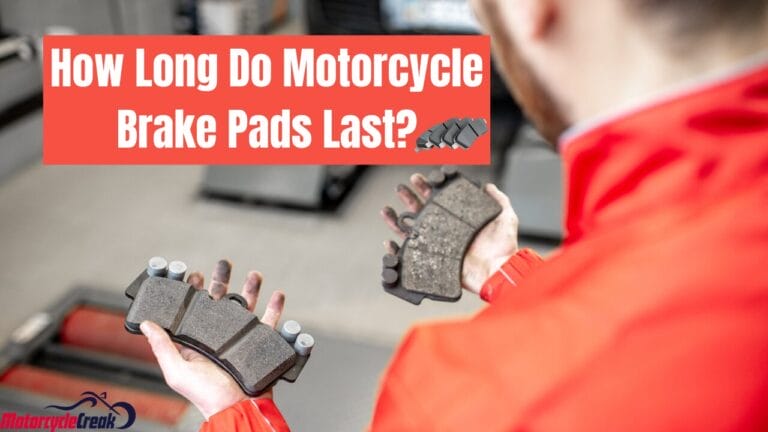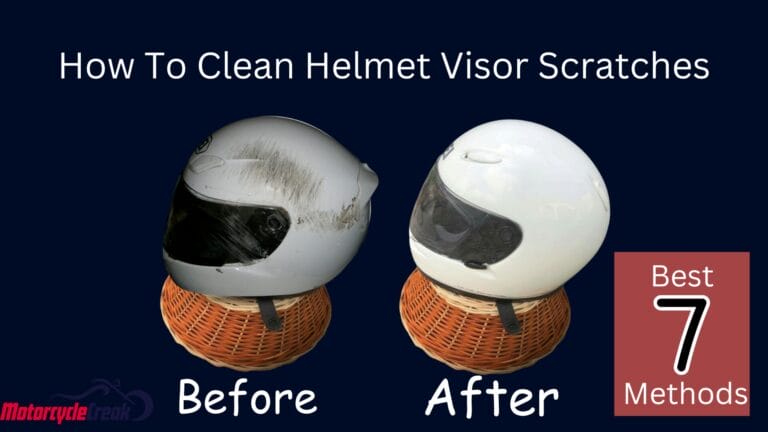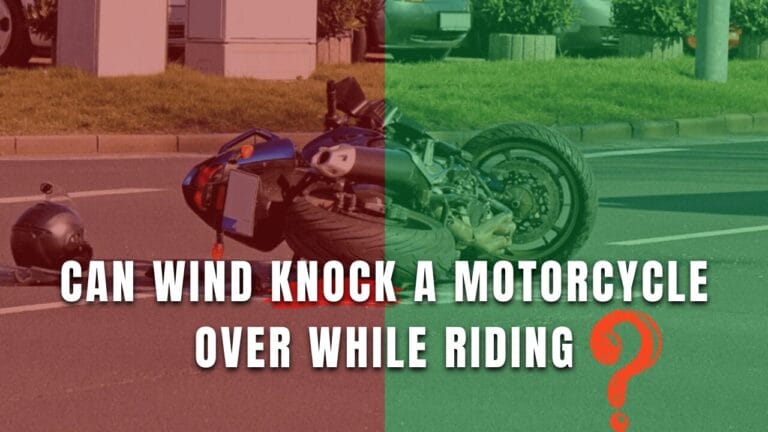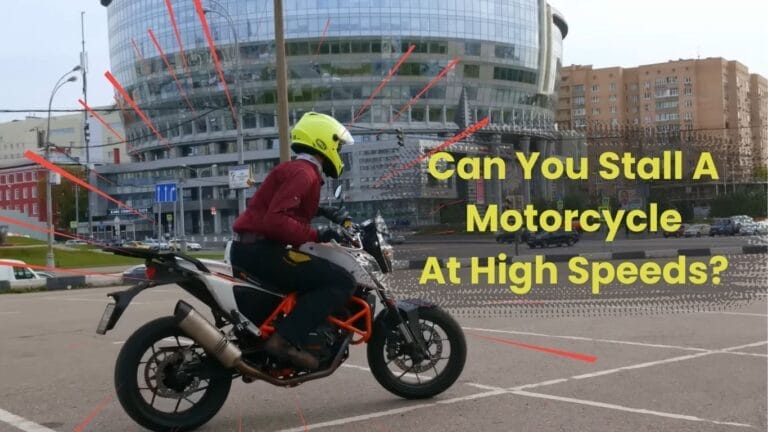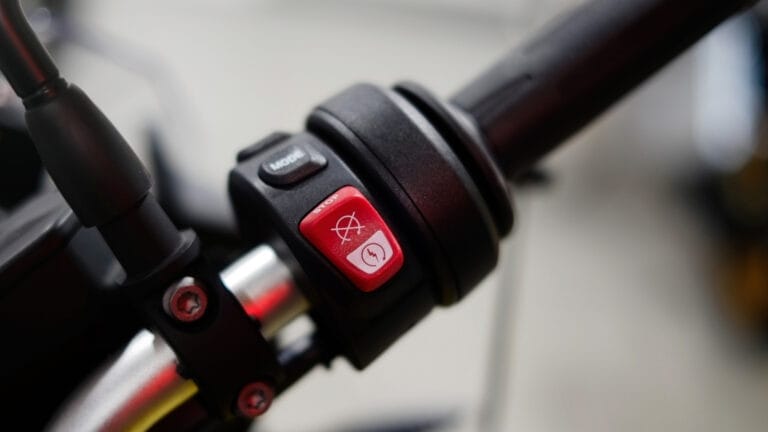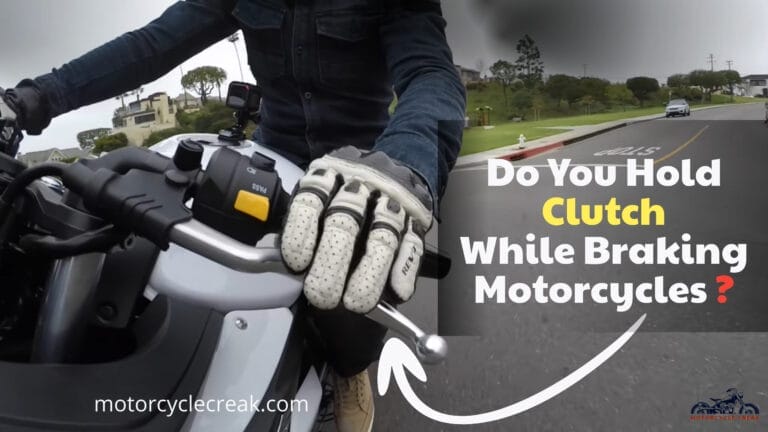Can You Rent a Motorcycle to Take the Test? A Complete Guide
Need a motorcycle for your test but don’t own one? You’re not alone. Many people face this challenge when preparing for their motorcycle licensing test. Maybe you’ve been practicing on someone else’s bike or simply don’t own one yet. Whatever the reason, the idea of renting a motorcycle for the test might seem like a perfect solution.
Renting is appealing because it offers convenience and access to a bike without the commitment of buying one. But is it even possible? And if it is, how does it work, and what do you need to know to get started?
This guide will walk you through everything you need to know about renting a motorcycle for your licensing test. We’ll cover rental policies, essential requirements, costs, and alternatives if renting isn’t an option. So read on—because this might just be the solution you’re looking for!
Table of Contents
Can You Rent a Motorcycle for the Licensing Test?
Yes, you can rent a motorcycle for the licensing test, but it depends on local rental policies and requirements. Some motorcycle rental companies and training schools offer this option, though you’ll need to meet certain conditions like holding a valid learner’s permit and providing proof of insurance.

Is Renting for the Test Allowed?
Most rental companies have policies about who can rent their motorcycles, and these often include restrictions for licensing tests. Some businesses, especially those focused on motorcycles, do allow it. However, major car rental companies that also rent motorcycles might not permit their bikes to be used for a test.
Another option is through motorcycle training schools or riding programs, which sometimes offer rentals specifically for licensing exams. These bikes are often beginner-friendly and already meet DMV requirements, making them an excellent choice.
What Are the Typical Requirements?
If you’re considering renting a bike, you’ll need to meet these common conditions:
- Valid Learner’s Permit or Driver’s License: Rental companies will require proof that you’re legally eligible to operate a motorcycle, even for a test.
- Age Restrictions: Many rental companies have a minimum age requirement, often 21 or 25.
- Insurance: You may need to provide proof of personal insurance or purchase additional coverage from the rental company.
- Credit Card for Security Deposit: Most rentals require a credit card on file for any potential damages or fees.
- Safety Gear: You might be required to have your own helmet and protective gear, though some companies provide them for an extra fee.
How to Rent a Motorcycle for the Test
Renting a motorcycle for your licensing test might sound like a tricky process, but with the right steps, it’s surprisingly straightforward. Let me explain how you can make it happen and avoid any hiccups along the way.
Step 1: Research Local Rental Services
Start by looking for motorcycle-specific rental companies or training schools in your area. These businesses are more likely to accommodate licensing test rentals compared to general car rental services.
- Check Online Reviews: Read reviews to ensure the company provides reliable bikes and good customer service.
- Call Ahead: Contact the rental service to confirm whether they allow their motorcycles to be used for licensing tests. This avoids wasted time on companies with restrictions.
Step 2: Understand Rental Terms and Conditions
Before booking, go through the rental terms carefully. This ensures you’re aware of all the requirements and avoid surprises.
- Eligibility Requirements: Verify if you meet age limits, licensing prerequisites, and insurance conditions.
- Bike Specifications: Confirm the rented motorcycle meets the DMV or testing center’s requirements, such as engine size and registration status.
- Liability Coverage: Ask about insurance policies and what they cover, especially during a licensing test. Some companies might require you to purchase extra coverage.
Step 3: Book Early
Rental bikes for licensing tests can be in high demand, especially during peak test seasons. Booking early ensures you secure a bike that meets your needs.
- Choose the Right Day: Schedule your rental for the test day and consider reserving extra time beforehand to familiarize yourself with the bike.
- Ask About Delivery Options: If transporting the bike to the test site is a concern, check if the company offers delivery services. It might cost extra, but it’s convenient.
Step 4: Practice on the Rental Bike
If possible, rent the motorcycle a day or two before your test. This gives you time to get comfortable with its controls and handling.
- Familiarize Yourself: Adjust to the feel of the brakes, clutch, and throttle so you’re confident on test day.
- Test Low-Speed Maneuvers: Practice common test exercises, like figure-eights and stops, to build confidence on the rental bike.
Step 5: Bring the Necessary Documents
Ensure you have everything required to complete the rental process smoothly.
- Your License or Permit: A valid learner’s permit is typically required to rent the bike.
- Proof of Insurance: Some rental companies may require your personal insurance details or offer temporary coverage.
- Credit Card for Security Deposit: Most rentals need a card on file for damages or fees.
- Rental Agreement: Keep a copy of the agreement in case the testing center asks for documentation.
Renting a motorcycle for your test doesn’t have to be stressful. With early planning, clear communication, and a bit of practice, you’ll be ready to ace your licensing test. Now here comes the good part—getting your motorcycle license and hitting the road with confidence
Challenges and Alternatives
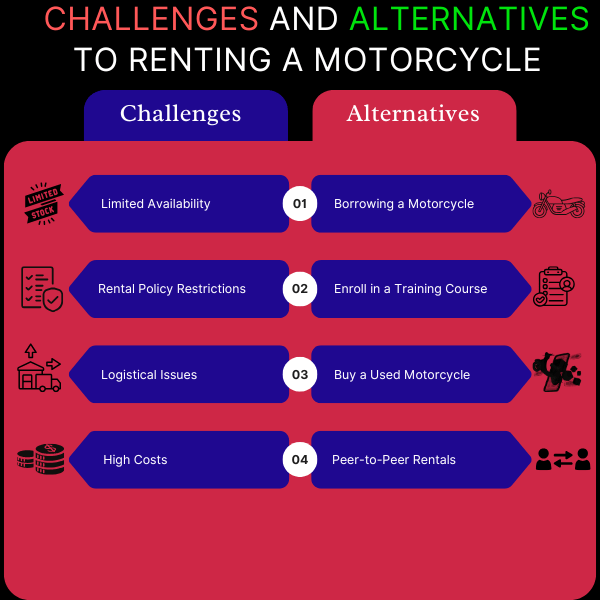
Limited Availability
Not all rental companies allow their motorcycles to be used for licensing tests. Even when they do, availability may be limited, especially during busy testing seasons. Booking early is your best bet to secure a bike.
Rental Policy Restrictions
Some companies require a licensed rider to accompany you or restrict where the motorcycle can be used. Always check the rental terms carefully to avoid surprises on test day.
Logistical Issues
Transporting the motorcycle to and from the testing center can be tricky if the rental company doesn’t offer delivery. Without a licensed rider to assist, you might need to explore alternative transportation options.
High Costs
Rental fees, deposits, and insurance can add up quickly. For a single day, the cost might rival other options, like borrowing a bike or enrolling in a training course that includes a motorcycle.
Alternatives to Renting
Borrowing a Motorcycle
Ask a friend or family member to lend you their bike. Ensure it meets the testing center’s requirements, including registration, insurance, and engine size. This can save you money and the hassle of dealing with rental policies.
Enroll in a Training Course
Many motorcycle training schools provide bikes for both practice and the licensing test. This is a convenient option that combines preparation and access to a bike in one package. Plus, the instructors often prepare you for the specific test format.
Buy a Used Motorcycle
If you’re planning to ride regularly after getting your license, investing in a budget-friendly used bike can be a smart choice. It provides a test-ready motorcycle and gives you the freedom to practice as much as you need.
Peer-to-Peer Rentals
Platforms like Riders Share or Twisted Road allow you to rent motorcycles directly from individuals. While not all listings permit use for licensing tests, it’s worth checking local options for availability.
Renting is one option, but it’s not always the easiest or most cost-effective. Borrowing a bike, enrolling in a course, or buying a used motorcycle are excellent alternatives. So read on for more tips to help you prepare for your licensing test with confidence!
Tips for a Successful Test Using a Rental Motorcycle
Renting a motorcycle for your licensing test can be a great option if you’re prepared. Here are five practical tips to ensure success:
Practice on the Rental Bike Before Test Day
- Familiarity is key. If possible, rent the motorcycle a day or two before your test to get comfortable with its controls, weight, and handling.
- Focus on slow-speed maneuvers, emergency stops, and other exercises you’ll be tested on. Practice builds confidence and reduces test-day nerves.
Confirm Testing Center Requirements
- Double-check that the rental motorcycle meets the DMV or testing center’s criteria, such as engine size, registration, and insurance.
- Bring all necessary paperwork, including the rental agreement, proof of insurance, and your learner’s permit.
Inspect the Bike Before the Test
- Do a quick pre-test inspection. Check tire pressure, brakes, mirrors, and fuel levels to ensure the bike is in good condition.
- Take a short ride to test the throttle, clutch, and braking responsiveness. This also helps you adjust to the bike.
Arrive Early and Stay Organized
- Plan to arrive at least 30 minutes before your scheduled test. This gives you time to set up, check the bike, and calm your nerves.
- Keep all your documents, safety gear, and keys ready to avoid last-minute stress.
Stay Calm and Focused During the Test
- If you make a mistake, don’t dwell on it—just focus on completing the next task confidently.
- Remember to cancel your turn signals after each turn, maintain smooth control, and listen carefully to the examiner’s instructions.
Preparation and confidence are your best tools for passing the test. Use these tips to make the most of your rental motorcycle and ace the exam on your first try!
Conclusion
- Recap Key Points: Summarize the process of renting a motorcycle for the test, including the requirements, challenges, and alternatives.
- Encourage Preparation: Remind readers to research their options, practice in advance, and verify everything with their testing center.
- Call-to-Action: Encourage readers to share their experiences or ask questions in the comments to help others in the same situation.


